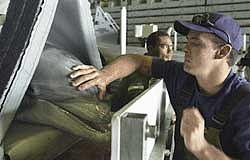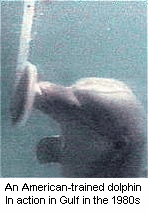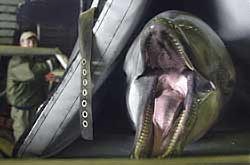   |
|
ANIMALS IN THE SERVICE OF THE MILITARY INITIAL BROADCAST: 24 November 1991 © Copyright 1991, Center for Defense Information. All Rights Reserved. | |
| HOST: Rear Admiral Gene LaRocque (USN, Ret.), Director, Center for Defense Information INTERVIEWER & NARRATOR: Sanford Gottlieb, Senior Producer, MARKETING & OPERATIONS: Mark Sugg PRODUCERS: Matthew Hansen, Lori McRea, Nick Moore, Daniel Sagalyn PRINCIPAL ANALYST & SCRIPTWRITER: Martin Calhoun |
PROGRAM PRODUCER: Daniel Sagalyn ORIGINATION: Washington, D.C. PROGRAM NO.: 510 Videotapes also available. Features commentary from: DONALD BROOKS: National Anti-Vivisection Society, Former Air Force Researcher RIC O'BARRY, Director, The Dolphin Project, Former Head Trainer of "Flipper" for TV show LAURIE RAYMOND, Dolphin Campaign Coordinator, Progressive Animal Welfare Society |
|
NARRATOR: Without elephants like this one, Hannibal might never have crossed the Alps. Without horses, Custer might have missed his "last stand." Without camels, Lawrence of Arabia might have been just another guy named Larry. For as long as there have been wars, animals both large and small have been drafted into military service. From the time-honored and traditional to the bizarre and controversial, humans have found a variety of uses for animals in the service of the military. ["AMERICA'S DEFENSE MONITOR" program introduction.] Admiral GENE LaROCQUE: Welcome once again to "AMERICA'S DEFENSE MONITOR." NARRATOR: Historically, probably no animal has had a greater impact on warfare than the horse. Riding ancestors of this horse, Genghis Khan and his Mongol horde swept through most of Asia. For centuries after horses first carried soldiers into battle, cavalry dominated infantry. Today, however, in the age of fast-moving tanks and high mobility vehicles, the only action many military horses see is at funerals and parades. NARRATOR: Today, the Army is still looking for "a few good dogs" to fill the ranks of its K-9
Corps. NARRATOR: Before there were combat radios, communication between the front lines and the rear often depended on a carrier pigeon's wings and a prayer. NARRATOR: During the Second World War, the US Army Air Corps contemplated unleashing a weapon on Japan the likes of which had never been seen before. NARRATOR: These are what the Pentagon refers to as "advanced biological weapons systems." They are part of the US Navy's marine mammal program. NARRATOR: The Navy studies and trains over a hundred dolphins, sea lions and beluga whales at underwater laboratories in San Diego, Key West and Hawaii. Of particular interest to the military is the dolphin.
RIC O'BARRY: The dolphin sonar is extremely sophisticated. It makes the human, manmade sonar look like a toy.
NARRATOR: While enlisted in the US Navy, Ric O'Barry received a commendation for his underwater work. Later, he became known for his work as head trainer of the animal television star "Flipper." More recently, O'Barry has been recognized for his outspoken opposition to keeping dolphins in captivity as president and director of the Florida-based Dolphin Project. He is also the author of Behind the Dolphin Smile.
Mr. O'BARRY: You could get a Russian ship and put everybody in American clothing, uniforms and put an American flag there and paint it just like an American ship and you could fool everybody, but you couldn't fool the dolphins because they know that steel was made in Russia. They can tell the density of metals and they can hit the alarm. And so, that makes them very valuable to the military.
NARRATOR: On at least two occasions since the marine mammal program began, the Navy has used dolphins in combat situations, reportedly for surveillance and mine detection. First in 1971
during the Vietnam War, then again in 1987 during tanker escort operations in the Persian Gulf. One of six dolphins deployed to the Persian Gulf died, the Navy reported, when it developed a bacterial infection. LAURIE RAYMOND: A lot of our scientific advisers indicated that they wouldn't have survived the transition there. In fact, Seattle and Vancouver and Tacoma zoos and aquariums have never been able to keep Atlantic bottle-nose dolphins in their collections because they don't survive.
NARRATOR: According to Ric O'Barry, even if they adjusted to their new environment, the dolphins, to mix a metaphor, might become "paper tigers" when confronted with any saboteur familiar with the species' behavior.
Mr. O'BARRY: I could swim right through their system and get to these submarines.
INTERVIEWER: How would you do that?
Mr. O'BARRY: Well, there's probably a hundred ways to do that. For example, one could take a fire extinguisher under water and, if the dolphin had never been trained to accept this foreign fire extinguisher, they would panic and just flee.
INTERVIEWER: Just at the sight of it?
Mr. O'BARRY: No. Well, setting it off. Or a hammer and a bell, many different things. They have to get used to every single thing. Just a diver underwater with a tank of air, for example, the first time they're exposed to that, they're afraid of it.
NARRATOR: O'Barry believes that entrusting serious military responsibilities to dolphins is not only a bad idea, but a dangerous one. Dangerous not just for the dolphins, but also for people.
Mr. O'BARRY: Dolphins are not dependable. You only have control over them while they're hungry. They're controlled by hunger. And once they are fed, you don't have control anymore. That's the real danger. NARRATOR: Like their human handlers, dolphins can be expected to make mistakes, sometimes with grave consequences.
Ms. RAYMOND: There was a reported incident in Havana Harbor in, I believe, 1963, when a dolphin was supposed to have attached a device to a Russian ship and, in fact, it returned to its own ship with the device still on and blew up its own transport.
NARRATOR: In January 1991, under mounting legal pressure, the Navy cancelled the dolphin submarine guard program citing budget concerns. However, other Navy work with marine mammals continues. Mr. O'BARRY: There's some talk about a "swimmer nullification system," and -- You can see the training of this in Key West; it's very hard for them to hide that.
INTERVIEWER: But that's a pretty nice euphemism. That means killing people?
Mr. O'BARRY: Yes.
INTERVIEWER: And do you think that dolphins are being trained to kill people?
Mr. O'BARRY: I think so, yes. In the sixties, the "swimmer nullification system," as I understand it, involved an injection system of CO-2. It sends a blast of CO-2 into the body cavity and will literally shove your insides out your mouth and your rectum.
NARRATOR: Additional details about the Navy's marine mammal program were alleged by former Navy trainers who went public with stories of overzealous training and mishandling of animals. Among them was a dolphin trainer who worked in the program from 1984 to 1989.
Ms. RAYMOND: He reported incidents of abuse that he had witnessed over the years working for SEACO, which is the sub-contracting training outfit for the Navy, where animals were starved, kicked, hit with bucket lids, put in a pen where they could see other animals being fed and not being fed themselves.
NARRATOR: The Navy denies that its trainers mistreat animals. NARRATOR: The Federal Marine Mammal Commission appointed a review team to investigate the allegations of abuse. In February 1989 it released its findings, which for the most part awarded the Navy a clean bill of health. The review team "found the allegations to be substantively lacking." NARRATOR: Nevertheless, the Navy has a long way to go before it persuades Ric O'Barry that America's dolphin draftees are anywhere near as happy as the Navy would have us believe.
Mr. O'BARRY: All of these Navy dolphins spend their life in a 24 by 24-foot space. We're talking about an eight-foot dolphin, perhaps. It can go three times its body length and its world ends. That's abusive, even if they don't do anything with them. Just to have them in that space is abusive. NARRATOR: "AMERICA'S DEFENSE MONITOR" wanted to talk with the Navy. It is the Navy's policy, however, not to discuss specific details of its marine mammal program other than to say that it uses its animals in underwater surveillance and to locate, mark and retrieve objects. NARRATOR: Because military aircraft often fly fast at low altitudes, collisions with birds are frequent.
PETER JENNINGS, ABC News broadcast, 28 September 1987: "One of the Air Force's most sophisticated aircraft, the B-1 bomber, crashed today near a training complex in BOB ZELNICK, same broadcast: "The plane, which was not carrying any bombs, went down on a practice mission about 60 miles southeast of Pueblo, Colorado. According to the Strategic Air Command, after taking off from Dyess Air Force Base in Abilene, Texas, the plane struck a flock of birds, which were sucked into its engine."
NARRATOR: Bird collisions with aircraft windshields can also spell disaster. NARRATOR: What you are seeing are birds being shot into windshields from a special cannon referred to as the "chicken gun."
NARRATOR: Pigs have been substituted for humans to test the effects of nuclear weapons. NARRATOR: For these descendants of Noah's Ark, being herded on to a boat meant something other than salvation. It meant a one-way trip to ground zero. NARRATOR: Biological agents and chemical weapons have also been tested on animals. DONALD BROOKS: I had an opportunity to re-evaluate when I was ordered to do an experiment which was scientifically invalid. I was told to radiate four trained Rhesus monkeys at a dose level which would occasion no behavioral change. So, I said, "No, I'm not going to do the experiment." NARRATOR: Through the years, the Air Force has defended experiments like these in order to learn more about the effects on pilots of flying through radioactive environments. NARRATOR: According to Barnes, animal experiments conducted for purposes such as this, experiments he performed for the Air Force, are pointless. They have no relevance to any military or, for that matter, human situation.
Mr. BARNES: When these data -- And this is a critical point. When these data go from the monkey laboratory into the Air Force and Army EM-1 manuals, journals, whatever they may be, they are relabeled. It says "Man Radiation Response Curve." It doesn't say a think about monkeys or where they came from. It was a direct one-to-one extrapolation.
NARRATOR: Barnes says that the experiments he performed for the Air Force, and the one he refused to perform, were also a tremendous waste of taxpayers' money.
Mr. BARNES: It used to cost us about $75 to buy a Rhesus monkey. By the time we finished with the materiel, the computer systems, the biometric services, all the people that went into this whole training thing, months had gone by and these animals were worth at least $50,000 apiece to the American taxpayer. When they killed those four monkeys, I said there's $200,000 that was not well spent.
NARRATOR: Using government data, In Defense of Animals, an animals rights groups, has estimated that half a million animals are used in military research each year at a cost of about Mr. BARNES: Animals to us were as expendable as nuts and bolts. If one died, we simply replaced the animal with another. I think that my unit alone was responsible for the deaths of over 1000 Rhesus monkeys or Vesicularus monkeys, but I was just one investigator, Sandy. I mean, there were investigators all around me, other people doing similar things with monkeys, or with dogs, or with mice, or rats, or other animals that were available there.
NARRATOR: "AMERICA'S DEFENSE MONITOR" invited the Pentagon and the Defense Nuclear Agency to respond to the issues raised in this program. Both declined. Mr. BARNES: Now I don't want to suggest that people are out there fraudulently thinking up experiments and doing these. People have been, as I was, conditioned to believe that the only way to gain these data is to use non-human animals and that it is a legitimate and reasonable scientific pursuit. I question that.
NARRATOR: Some military use of animals may be necessary and justified, others may not be.
But one thing is certain. Animals of all kinds have played a big part in both war and the preparations for war.
Admiral LaROCQUE: Wow! That was pretty rough stuff, I'm sure you will agree, a lot rougher than I thought it would be. When I was a young man preparing to be an officer in the United States cavalry, I thought it would be fun to dash off to battle on a horse. I never once considered what the horse might think of this whole operation. Today, we are obviously using a lot of animals to prepare for and to wage war, and I think that's a bit unfair on the animals we're using. [End of broadcast.]
CONDITION OF USE: Credit "AMERICA'S DEFENSE MONITOR"
| |



.jpg)